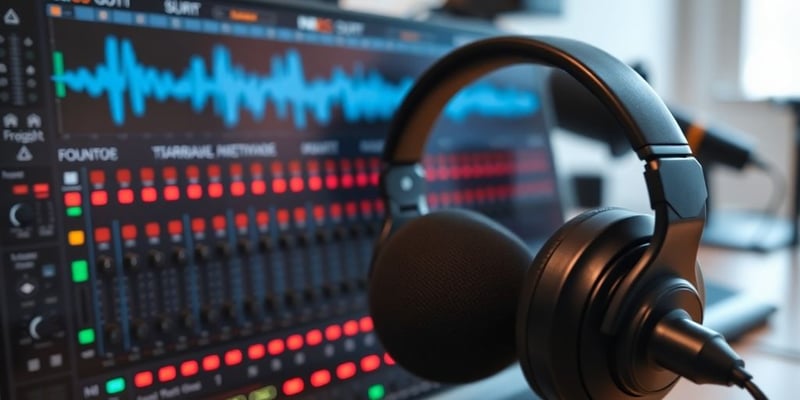
Mastering the Art of Voice Synthesis: How to Clone Voice Effortlessly
Save 15%

Voice cloning is like magic, but for your ears. Imagine being able to recreate a voice so perfectly that it's hard to tell the difference from the real thing. Whether you're into tech or just curious, understanding how to clone voice can open up a world of possibilities. From making audiobooks in different languages to giving a digital assistant your own voice, the potential is huge. But, like all powerful tools, it comes with responsibilities. Let's dive into the ins and outs of this fascinating technology, exploring how it works, where it's used, and the ethical questions it raises.
Key Takeaways
- Voice cloning allows for the creation of synthetic voices that sound incredibly real.
- Advanced AI techniques like GANs and deep learning make voice cloning possible.
- Voice cloning has applications in entertainment, education, and accessibility.
- Ethical concerns include misuse and privacy issues.
- Curating a quality voice dataset is crucial for successful voice cloning.
Understanding the Basics of Voice Cloning
What is Voice Cloning?
Voice cloning is a fascinating technology that allows you to create a digital copy of a person's voice. It uses AI voice cloning to mimic the unique characteristics of someone's speech, like their tone, pitch, and accent. This isn't just about imitating how someone talks; it's about capturing the essence of their voice, making it sound as if they are speaking, even when they aren't.
How Does Voice Cloning Work?
The process of voice cloning involves several steps. First, you need a good amount of audio data from the person whose voice you want to clone. This data is then analyzed to pick up on specific vocal traits. Once these traits are understood, AI models use this information to generate a voice that sounds just like the original. It's like teaching a computer to speak with someone else's voice.
Key Technologies Behind Voice Cloning
Several technologies make voice cloning possible. Deep learning algorithms play a big role. They analyze and learn from large datasets of audio recordings. Neural networks, particularly those designed for voice processing, help in understanding and replicating the complex patterns of human speech. Additionally, advancements in machine learning have paved the way for more accurate and efficient voice cloning methods, allowing for quicker and more realistic voice synthesis.
Exploring Advanced AI Techniques for Voice Cloning
Deep Learning in Voice Cloning
Deep learning has really changed the game when it comes to voice cloning. With these advancements, creating voices that sound incredibly real and personal is now possible. Deep learning models can capture the unique quirks of a person's voice, including pitch, tone, and even emotional nuances. This means that with enough data, you can replicate a voice that feels authentic and lifelike. It's fascinating how these models work by processing vast amounts of voice data to understand and mimic the nuances of human speech.
Generative Adversarial Networks (GANs)
GANs have been a huge breakthrough in the field of voice cloning. They work by having two neural networks compete against each other, which helps in creating voices that sound more human-like. This technology allows for the generation of speech that closely matches the natural patterns of human speech. One of the coolest things about GANs is their ability to work with limited data, making it possible to clone voices even when you don't have a lot of samples.
Zero-Shot Voice Cloning
Zero-shot voice cloning is like magic in the world of AI. Imagine being able to clone a voice without having any prior samples of that voice. This technique uses advanced algorithms to analyze a small audio sample and then replicate the voice accurately. The challenge here is to maintain the naturalness and emotional depth of the voice, but researchers are making great strides in this area. It's exciting to think about the possibilities this opens up, especially for AI voice cloning where data might be scarce.
Applications of Voice Cloning in Various Industries
Voice Cloning in Entertainment
Voice cloning is shaking up the entertainment industry big time. Imagine watching an animated movie where your favorite actor's voice is brought to life without them even stepping into a recording studio. That's the magic of voice cloning. It's being used to create lifelike voiceovers for films, video games, and even virtual reality experiences. This technology allows creators to preserve the voices of iconic characters, even when the original actors are no longer available. Plus, it opens up endless possibilities for dubbing films in multiple languages, making content more accessible to global audiences.
Educational Uses of Voice Cloning
In education, voice cloning is like a teacher's secret weapon. It can create personalized learning materials that speak directly to students in voices they recognize and relate to. This can be especially helpful for language learning, where hearing a familiar voice can make lessons more engaging and easier to understand. Moreover, it enables the development of educational tools that can adapt to different learning styles and paces, offering a more tailored educational experience.
Voice Cloning for Accessibility
Voice cloning also plays a crucial role in making technology more accessible. For individuals with speech impairments, cloned voices can provide a means to communicate more naturally and personally. It's also used in text-to-speech applications for the visually impaired, allowing them to listen to written content in a voice that feels natural and familiar. Furthermore, voice cloning can aid in creating more inclusive voice-activated systems that recognize and respond to a wider range of vocal inputs.
Voice cloning technology has diverse applications across industries like entertainment and e-learning, enhancing user experiences and accessibility. It allows for the creation of realistic voice replicas, facilitating personalized content delivery and innovative solutions in various fields. Explore more about voice cloning technology.
Ethical Considerations in Voice Cloning

Voice cloning is like a double-edged sword. It can be super cool, but it also comes with a bunch of ethical headaches. Understanding these ethical concerns is crucial for responsible use.
Potential Misuses of Voice Cloning
Voice cloning isn't just about creating fun voiceovers; it can be used for some pretty shady stuff. Imagine someone using your voice to say things you never said. That's a real risk with this tech. Some of the potential misuses include:
- Identity Theft: Bad actors might clone voices to impersonate others, leading to fraud or deception.
- Deepfake Audio: Creating audio clips that sound real but are completely fake, which can be used to spread misinformation.
- Unauthorized Voice Replication: Cloning someone's voice without their permission, which can lead to privacy violations.
Privacy Concerns
Privacy is a big deal, especially when it comes to voice cloning. People need to know their voice won't be used without their say-so. Here are some privacy issues to think about:
- Consent: It's not always clear if someone has agreed to have their voice cloned. The ethical landscape of voice replication technology emphasizes the importance of clear consent and ownership.
- Data Security: Protecting the audio data used in cloning is essential to prevent unauthorized access.
- Voice Data Ownership: Who owns the rights to a cloned voice? This question is still up in the air.
Regulatory Challenges
When it comes to rules and regulations, voice cloning is still kind of the Wild West. There aren't many laws in place yet, but there should be. Some challenges include:
- Lack of Legal Frameworks: Many regions don't have specific laws regarding voice cloning, making it difficult to address misuse.
- Enforcement Issues: Even if laws exist, enforcing them can be tricky, especially across different jurisdictions.
- Need for Ethical Guidelines: Developing clear ethical guidelines can help steer the proper use of voice cloning technology.
Voice cloning offers fantastic possibilities, but it also brings ethical dilemmas that need careful consideration. Balancing innovation with responsibility is key to harnessing its full potential without crossing ethical boundaries.
Building a High-Quality Voice Dataset
Curating Audio Recordings
To start building a voice training dataset, you need to gather clear and precise audio recordings. Using a high-quality microphone is key to capturing clean audio free from background noise. Here are some steps to follow:
- Select the Right Environment: Choose a quiet location to minimize external noise. Use soundproofing if possible.
- Script Preparation: Prepare your scripts ahead of time. This ensures consistency and covers all necessary phonetic sounds.
- Recording Sessions: Keep your sessions short to avoid fatigue, which can affect voice consistency.
Ensuring Dataset Reliability
Reliability in your dataset means having consistent and accurate data. This involves:
- Regular Monitoring: Continuously check for any errors or inconsistencies in your recordings.
- Quality Control: Implement a review process to ensure each recording meets your standards.
- Backup Plans: Always have a backup of your data to prevent loss.
A reliable dataset is the backbone of successful voice cloning, ensuring the model learns from the best possible examples.
Open-Source Audio Resources
Open-source datasets can be a great asset. They not only save time but provide a variety of voices and accents. Some popular options include:
- Spoken Commands Dataset: Offers a wide range of voice samples for testing.
- VOiCES Dataset: A rich resource for developing voice cloning models.
- Children's Song Dataset: Contains diverse recordings, perfect for experimenting with different voice cloning techniques.
Continuous Improvement and Refinement of Voice Clones
Iterative Refinement Techniques
Improving a voice clone is kind of like baking a cake. You try different ingredients, tweak the recipe, and keep at it until it tastes just right. Iterative refinement is the secret sauce here. You take the output from one round, make some changes, and feed it back into the system. Small tweaks, like adjusting learning rates or playing around with the model's architecture, can make a big difference. It's a bit like tuning a guitar—tiny adjustments can change the whole sound.
Optimizing Model Performance
Getting the best out of a voice cloning model means keeping an eye on the details. You might need to run the training process for more epochs or fine-tune the learning rate. It's all about finding that sweet spot where the model captures those subtle vocal nuances that make a voice sound real. Sometimes, even a bit of data augmentation can help, like adding background noise to make the clone handle real-world conditions better.
Evaluating Voice Clone Quality
How do you know if your voice clone is any good? Well, you have to test it. Listen to the output and compare it with the original. Is it close? Does it sound natural? You could also use some quantitative metrics, but at the end of the day, it's your ears that make the call. If it sounds off, go back and adjust those parameters or try a different model setup. It's a cycle of trial and error, but each round gets you closer to a perfect clone.
Voice cloning is not just about getting a voice to sound right—it's about making it feel right. The journey of refining a voice clone is ongoing, and each tweak brings it closer to sounding like the real deal.
For those interested in exploring the advancements in AI voice cloning, it's a fascinating field with endless possibilities. As the technology evolves, so do the methods for refining and perfecting voice clones, making it an exciting area to watch.
Tools and Platforms for Voice Cloning

Popular Voice Cloning Tools
Voice cloning has come a long way, and there are several tools out there making waves. Overdub is one such tool, part of the Descript platform, known for its ability to create realistic voice outputs from existing recordings. It's great for audio editing and content creation. Then there's Playht, Murfai, and Speechify, each offering unique features for voice cloning. Whether you want to clone your voice or create one on demand, these tools have got you covered.
Features of Voice Cloning Platforms
When picking a voice cloning platform, it's all about the features. Look for platforms that offer real-time voice synthesis, multilingual support, and easy integration with other tools. Some platforms even let you tweak the voice to match different emotions or tones. It's also important to consider the quality of the voice output—does it sound natural and human-like? These are the things to keep in mind.
Choosing the Right Tool for Your Needs
Choosing the right tool depends on what you need it for. Are you looking for something simple to use, or do you need advanced features for professional use? Think about the kind of projects you'll be working on. If you're into entertainment or need something for educational purposes, make sure the tool supports those areas. Also, consider your budget—some tools come with a hefty price tag, while others offer more affordable options or even free trials.
Wrapping It Up: The Future of Voice Cloning
So, there you have it. Voice cloning is no longer just a sci-fi fantasy; it's here and it's changing the game. From making animated characters talk to bringing back voices from the past, the possibilities are endless. But, like with any tech, there's a flip side. We gotta think about the ethics—how do we keep it from being misused? As we move forward, it's all about finding that sweet spot between innovation and responsibility. Whether you're a tech geek or just curious, voice cloning is something to keep an eye on. It's a wild ride, and we're just getting started.
Frequently Asked Questions
What is voice cloning?
Voice cloning is a technology that lets you make a digital copy of someone's voice. It uses computer programs to listen to and learn how a person talks, then makes a voice that sounds just like them.
How does voice cloning work?
Voice cloning works by using computer programs that learn from recordings of a person's voice. These programs understand the way someone speaks, including their tone, pitch, and accent, and then create a digital voice that mimics those features.
What are some uses for voice cloning?
Voice cloning is used in many areas, like making characters in movies and video games sound real, helping people with disabilities communicate, and creating personalized digital assistants.
What are the ethical concerns of voice cloning?
There are worries that voice cloning could be misused, like making fake recordings of someone saying things they never did. Privacy and consent are big concerns too, as people might not want their voice cloned without permission.
How can I build a good voice dataset for cloning?
To build a good voice dataset, you need clear recordings of a person's voice. It's important to have different kinds of speech, like talking fast or slow, and to make sure the recordings are of high quality.
What are some popular voice cloning tools?
Some popular tools for voice cloning include programs like Playht and Murfai. These tools help users create voice clones quickly and can be used for different purposes, like making audiobooks or virtual assistants.









